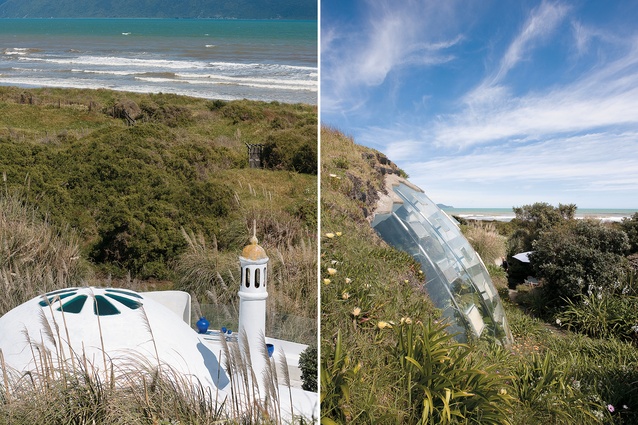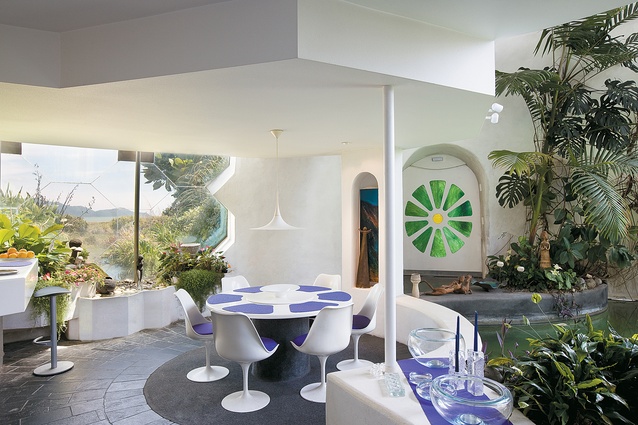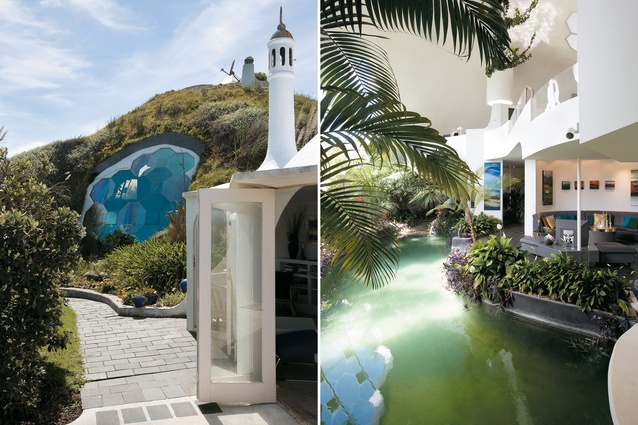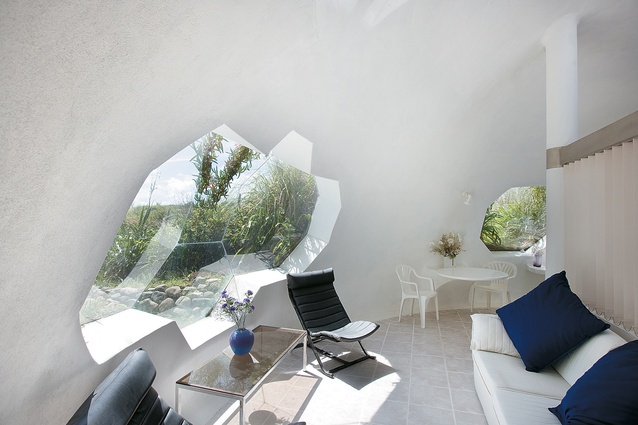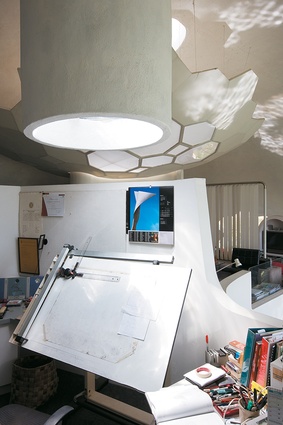Houses Revisited: Dome house
First published in 2008, we review this early Nineties, sustainable home on the Kapiti Coast by iconic modernist architect Fritz Eisenhofer.
In the dunes of Peka peka, 60km north of Wellington, lies, half-submerged in the sand, a dome. It might have dropped from the sky or rolled in from the sea. The smooth concrete surface is interrupted by areas of faceted glass. Sand rises up and over the dome in places and with it, vegetation. It is clearly not of this planet.
And yet it is of this earth. This is the house of architect Fritz Eisenhofer and his wife Helen. It is also their passion and their pride, and an extraordinary experiment in environmental design and a fine example of what can only be described as modern living. Built of ferro-cement, the house has a rock store where the heat of the summer is stored to be released slowly through the winter months. A pool dominates the space inside where the vegetation is as abundant as it is outside. The sand on the roof serves to insulate this early biosphere. The house is subsumed into the land, literally.
Fritz Eisenhofer came to New Zealand via Australia, where he worked erecting pre-fabricated houses imported from his native Austria. He continued this work when he arrived in Titahi Bay where 500 of these houses still stand. After working with the Housing Division of the Ministry of Works he went on to practice architecture on his own.
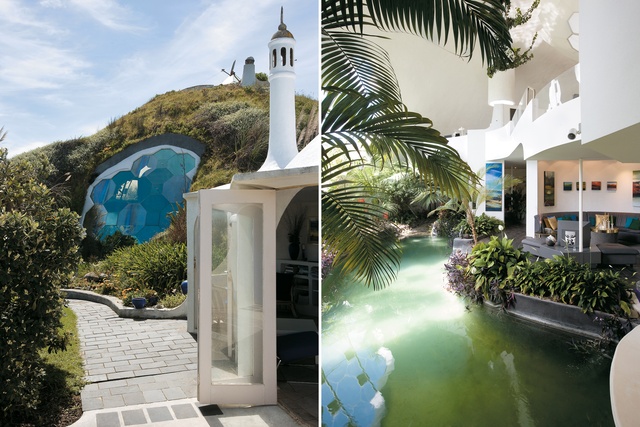
In a career spanning 50 years he has designed – and often built – a number of notable houses in and around Wellington. Fritz says he “always likes to do something different” when designing a new house. He and Helen have built each of the houses they have lived in, including their house in Rama Crescent in Khandallah, a much-fêted example of modernism.
In the early 1980s the Eisenhofers became interested in earth shelters, attending the first world congress on solar energy in Perth in 1983. They came back excited about the possibility of building virtually underground. Wellington city was too precipitous to attempt this and eventually they found a site in Peka Peka.
Fritz Eisenhofer designed the house in the late ’80s and the couple started building in 1991. The ferro-cement dome was built up from the ground with scaffolding and a series of steel rings as guides. A special mesh holds together the skin which is merely 30mm thick. Once the structure was completed from the inside, the scaffolding was removed and the exterior was plastered. Insulation was added to the outside and sand was bulldozed over the top to bury the dome. Fritz Eisenhofer built the house with two retired boatbuilders in their seventies.
The pool absorbs the hot sun in the summer, acting as a heat sink. A fan at the top of the dome moves the warm air into the rock store where it increases the heat of the rocks. This acts, as Fritz explains, “like a very big nightstore heater”, slowly releasing the heat through the winter, maintaining the temperature inside at 20 degrees. The fireplace is “just for show” and isn’t needed to keep the house warm.

The tropical plants grow near the windows where the condensation drips down and waters them. Over the years Fritz and Helen have had to remove a creeper that threatened to cover the inside surface of the dome and a palm that wanted to bust through. Peace lilies like the environment best, growing well and cleansing the air. There are no opening windows and the flow of fresh air is regulated with doors at the entrance and bottom of the dome.
The dome, which has a diameter of 18 metres, is surrounded by three smaller domes, each eight metres in diameter: the garage and guest room at the top and the spa room at the bottom. Entrance is through an anteroom and then into the dome itself, arriving near the top of its arc. A paved path leads up to a private mezzanine and down to the living areas. The space is very fluid and right angles are hard to find.
At the heart of the lower area is the sitting area with fixed circular seating and a round table right at the centre of the dome. In winter, light from the two north-facing windows across the pool penetrates deep into this sitting area. The space between the windows houses the solar panels on the exterior that assist with heating.
A few steps further down is the Corian kitchen and the west-facing window, glazed with reflective glass to minimise heat gain. The dining area floats like an island close to the pool. The paved path continues through a door to the spa pool and from there to the outside with, on one side, a secluded sitting area, and on the other, a summer house. Inside, the path winds back up past the entranceway to the mezzanine, which floats above the spaces below, almost unconnected to the walls.
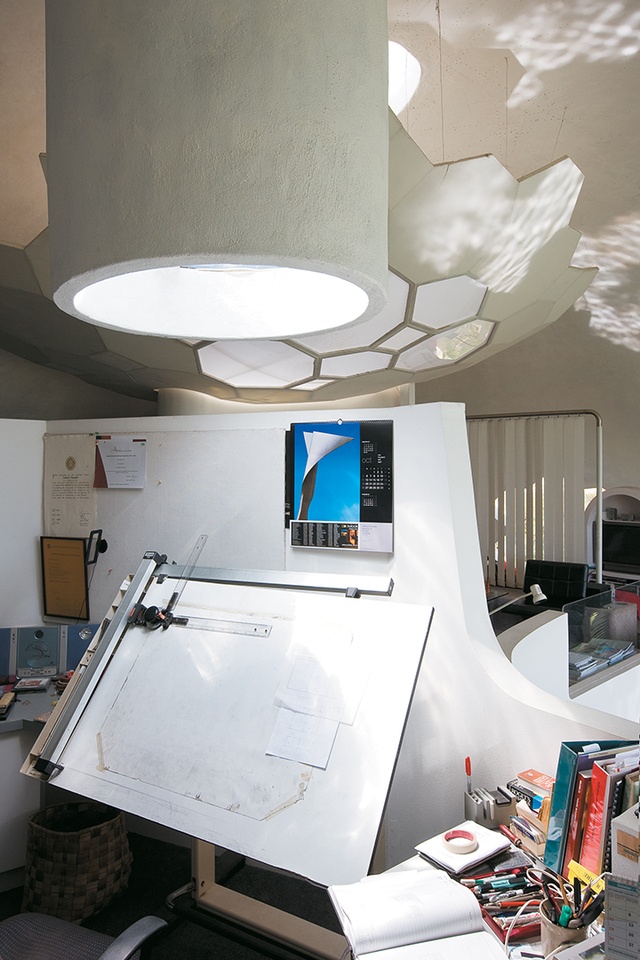
To the right is Fritz’s office, with a tubular skylight delivering bright light to his still active drawing board. In the centre of the mezzanine is a sitting area mirroring the one below. Beyond is the open plan bedroom area which sits above the kitchen, complete with wardrobe and bathroom and a sewing area with the best view in the house, across to Kapiti Island.
Floating above the mezzanine is a geometric web of polystyrene and acrylic panels that absorb sound and filter light from the skylights above. The guest room is a precise yet fluid collection of spaces within its own 8 metre-wide dome. The Eisenhofers built this first and lived in it while building the main house. The bedroom is in the centre with a sitting area by the window, an economical kitchen to one side, and a bathroom to the rear.
Fritz and Helen Eisenhofer have built their own world under a dome which is both local and exotic, earthly and alien. It is an exemplar of environmental living and a successful experiment in the use of energy, undertaken long before it was fashionable – or necessary.
Click here to see more Houses Revisited. And sign up to our email newsletters to receive Houses Revisited straight to your inbox.

